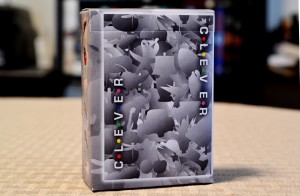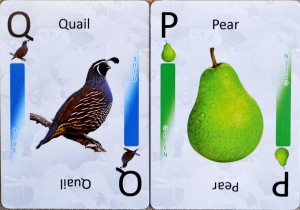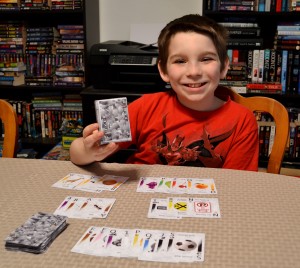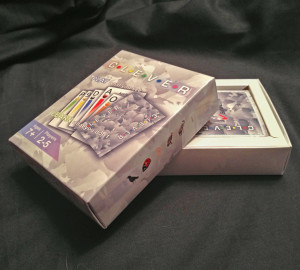I’ve always maintained that knowledge (or lack thereof) is one of the reasons we often fail in our day to day tasks. As such, I think we can all agree that any game that has educational value is worth more than the sum of its parts. “CLEVER”, a card game that will hit Kickstarter in late November 2013, is one such item. Before we get started taking a look at this game in further detail, I’d like to thank Jason Santa Maria from IN8 Games for providing me with a press copy. It’s important to stress that prototypes are often not representative of the final product, making the below subject to change. My copy, for example, included all of the cards players would see in the final version but didn’t come packaged in the official box. I included a picture of the box (provided by the developer) at the end of this article for your viewing pleasure.
One of the first things worth mentioning about this product is that there are multiple ways to make use of it. “CLEVER” isn’t just one game…it’s actually a template that allows players to come up with their own game variants. Not to worry, the rulebook does list a few ways to play in case you need some inspiration. What’s more, the developer is planning to introduce a special “CLEVER Community” section on the official website (linked below) that allows players to submit their own game variants for all to use.
As I mentioned above, the components in a prototype are usually not representative of the final product. With that said, I do have to compliment the detail and colorful nature of the cards themselves. Each card lists the name of some sort of object (apple, trumpet, zebra, etc.) along with an appropriate and amazingly detailed picture. I can’t speak for the final product, but the pictures in the prototype were superbly done. Each card also has a colored bar on either side of the picture, representing the primary color of the object in question. Lastly, either the first letter of the object or the number of objects shown is listed on the upper left corner of the card.
So now that we have these cards in front of us, just what are we supposed to do with them? In all honesty, anything you want. The deck as a whole covers color & name recognition, sequencing, spelling, math, and category matching all in one sitting. As a result, the deck could be used to cover just one or two of the above elements or simply all of them. Needless to say, this flexibility will come in handy in the classroom…it’s rare to find a game that you can pull out during both spelling and math class. In case you’re curious about specifics, the deck includes a total of seventy-four cards which are broken up into two sets of alphabet letter (52 “A-Z”) cards, two sets of number (20 “1-10”) cards, and two wild/category cards. A total of twelve categories and twelve colors are covered.
Most of the games we tried had a “Rummy” theme to them in that they tasked players with getting rid of as many cards from their hand as possible. Some of them like the variant titled “Three” are still a work in progress, but were admittedly enjoyable as-is. “Three”, just to give you a brief overview, lays out its playing field in a total of three stacks. Players will be adding cards to these three stacks, attempting to match or exceed the number of related items on the three cards. Matching items can be associated by color, category, shape…you name it. Those who can’t play a card that keeps the number of matched items at its current value will have to take all of the cards in a particular stack. Whoever has the least amount of cards in their personal “score” stack at the end of the game wins. That’s not the full rule set mind you, but I can vouch that it’s fun to play.
Of course, those with younger kids could opt for something a bit simpler…not that “Three” is all that difficult to play. “CLEVER” could be used as a set of flash cards for those of you with little ones who are still grasping the concept of where the parent goes every time they play “Peek-a-boo”. In an adult setting, games like the aforementioned “Three” work fairly well as it forces players to draw parallels and think outside of the box. There’s also a little strategy in the cards you play, as you’ll be trying to lay cards down that trumps everyone else. Picking combinations that are difficult to play off of can really ruin someone else’s day, giving you ample time to get rid of all of your cards and cross the finish line first. Playing this game with adults as opposed to kids will alter your gameplay experience a bit, though “CLEVER” manages to accommodate either scenario in spades.
While it’s obvious that “CLEVER” has a high educational value in the classroom, I found it to be an excellent product to bring out on game night. The varied nature of the games offered and the flexibility behind the cards allow players of any age to make the game as educational as they want it to be, meaning that adults can join in on the fun too. Creative individuals will no doubt find new ways to play, who in turn have the option of sharing their variants with others in the online community. To sum this product up, “CLEVER” offers endless possibilities and is indeed an excellent idea worth supporting.
—
You can learn more about and support the game by visiting the following websites:
http://www.clevercardgame.com/
http://www.kickstarter.com/projects/2092880210/clever-play-what-you-see-learn-what-you-dont
You can try out the variant I invented by downloading the PDF featured below:
—





Vince,
Thanks so much for the wonderful preview you did of CLEVER! I’m all kinds of excited to get this game made and out to people to enjoy! I’m also looking forward to being able to showcase the game you and your kids came up with using the CLEVER deck- Spelled Out! So Cool!
Thanks again!
Sincerely,
Jason Santa Maria
My pleasure, Jason! Good luck with the campaign, I’ll be rooting for you! 🙂